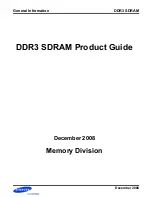
Datasheet
69
Thermal Management
5.2.3.2
Processor Thermal Data Sample Rate and Filtering
The processor digital thermal sensor (DTS) provides an improved capability to monitor
device hot spots, which inherently leads to more varying temperature readings over
short time intervals. To reduce the sample rate requirements on PECI and improve
thermal data stability vs. time the processor DTS implements an averaging algorithm
that filters the incoming data. This filter is expressed mathematically as:
PECI(t) = PECI(t-1)+1/(2^^X)*[Temp - PECI(t-1)]
where:
•
PECI(t) is the new averaged temperature
•
PECI(t-1) is the previous averaged temperature
•
Temp is the raw temperature data from the DTS
•
X is the Thermal Averaging Constant (TAC)
The Thermal Averaging Constant is a BIOS configurable value that determines the time
in milliseconds over which the DTS temperature values are averaged (the default time
is 256 ms). Short averaging times will make the averaged temperature values respond
more quickly to DTS changes. Long averaging times will result in better overall thermal
smoothing but also incur a larger time lag between fast DTS temperature changes and
the value read via PECI.
Within the processor, the DTS converts an analog signal into a digital value
representing the temperature relative to PROCHOT# circuit activation. The conversions
are in integers with each single number change corresponding to approximately 1°C.
DTS values reported via the internal processor MSR will be in whole integers.
As a result of the PECI averaging function described above, DTS values reported over
PECI will include a 6-bit fractional value. Under typical operating conditions, where the
temperature is close to PROCHOT#, the fractional values may not be of interest. But
when the temperature approaches zero, the fractional values can be used to detect the
activation of the PROCHOT# circuit. An averaged temperature value between 0 and 1
can only occur if the PROCHOT# circuit has been activated during the averaging
window. As PROCHOT# circuit activation time increases, the fractional value will
approach zero. Fan control circuits can detect this situation and take appropriate action
as determined by the system designers. Of course, fan control chips can also monitor
the PROCHOT# pin to detect PROCHOT# circuit activation via a dedicated input pin on
the package.
§















































